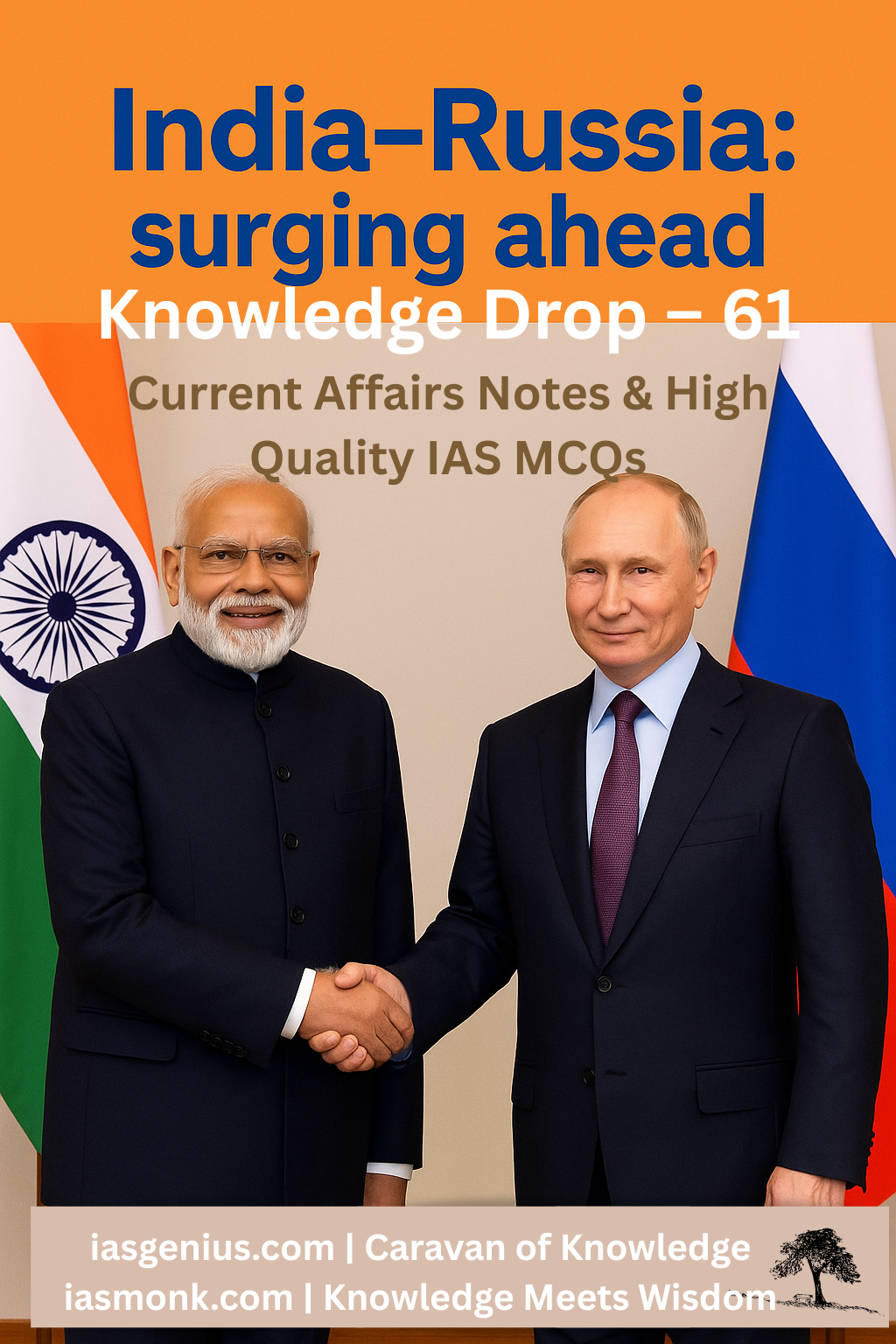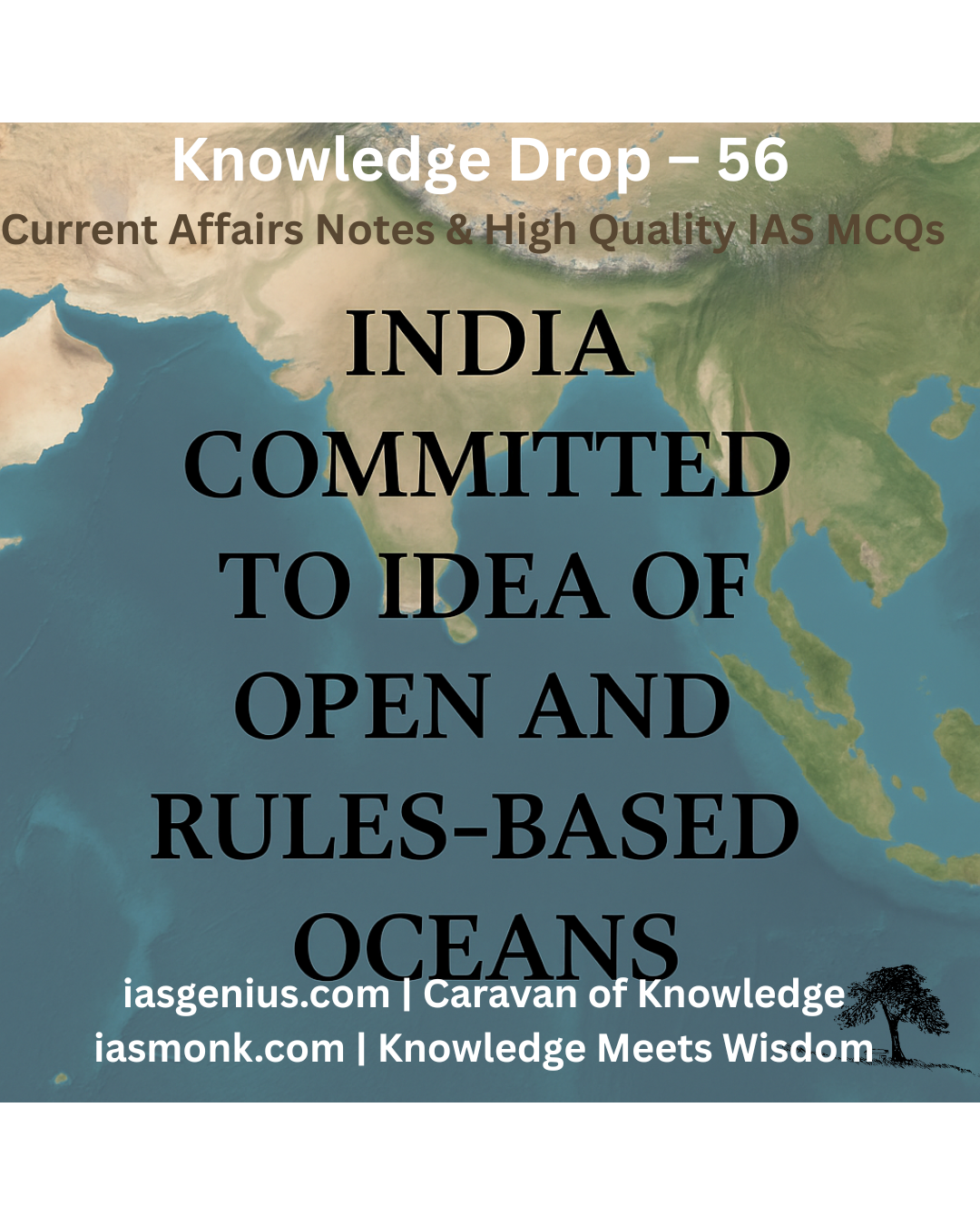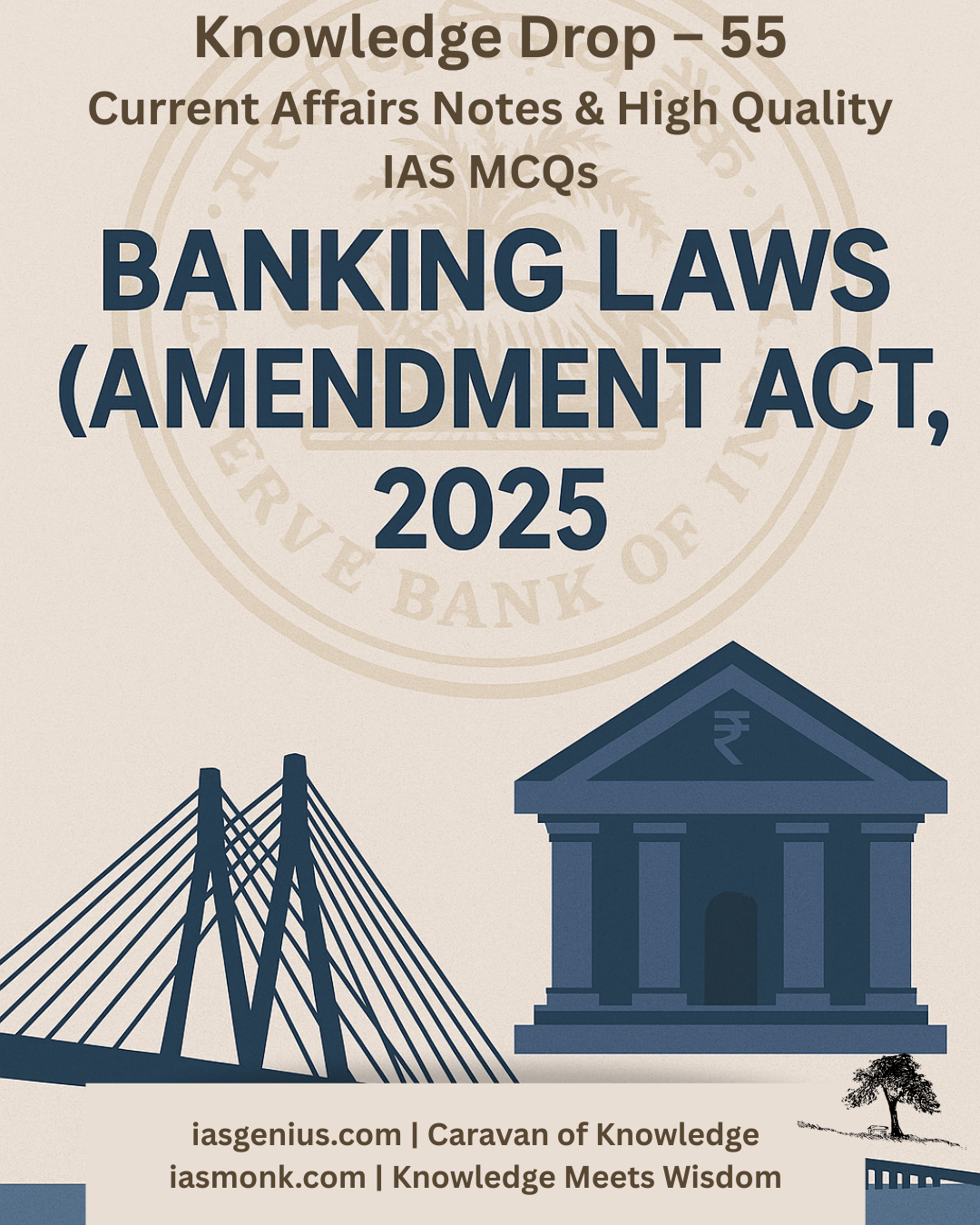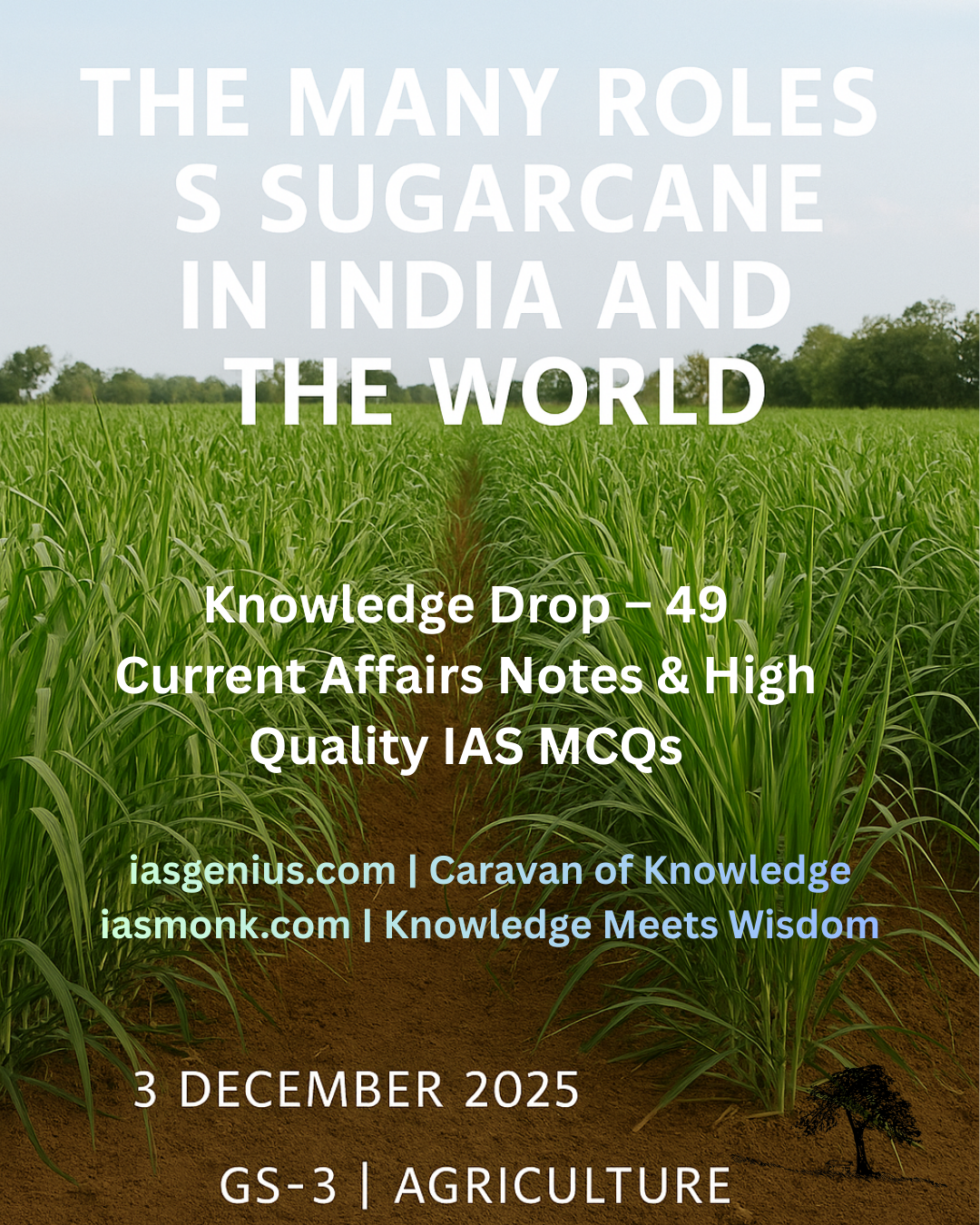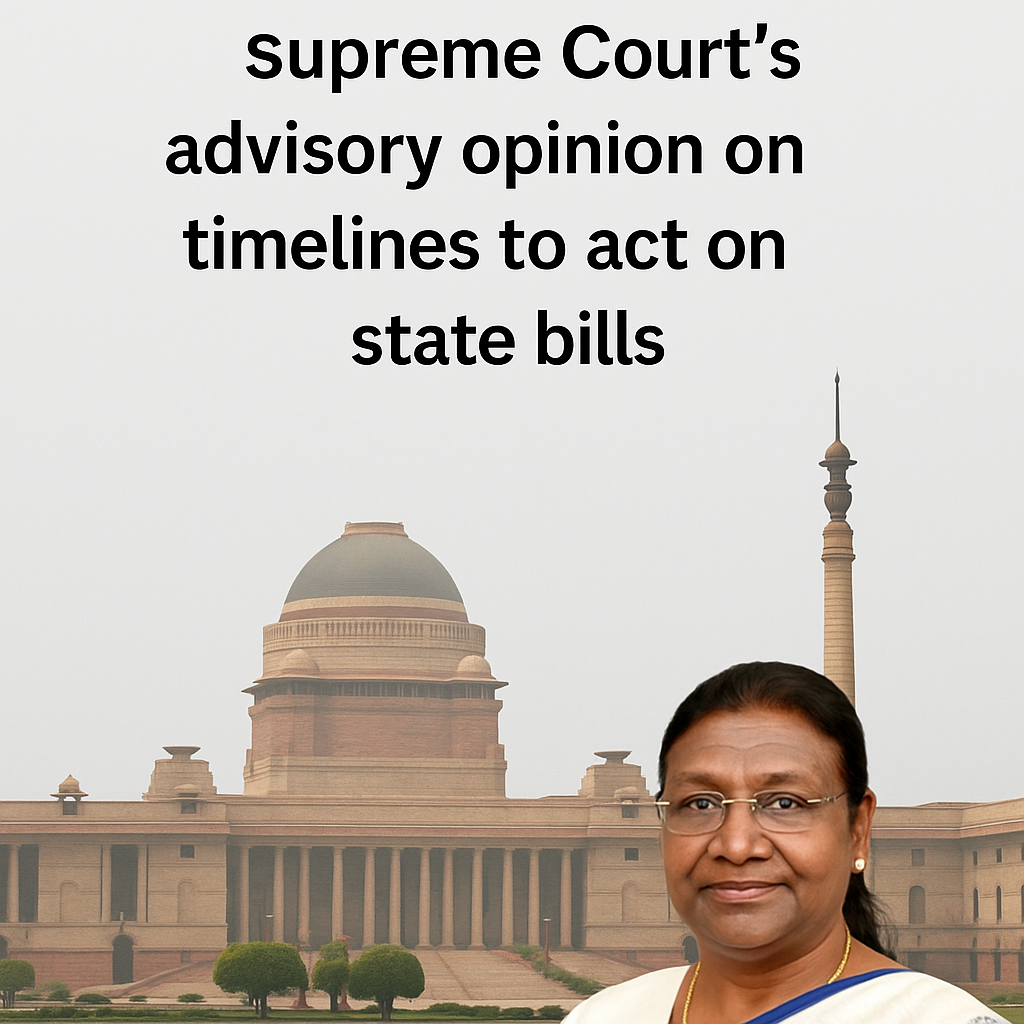
May 16, 2025, Post 4: When the Constitution Asked a Question Back | High Quality Mains Essay | Prelims MCQs
When the Constitution Asked a Question Back

📅 Post Date:
May 16, 2025
🎯 Thematic Focus:
Judiciary | Federalism | Constitutional Morality | Separation of Powers
🕊️ Opening Whisper
In the silence of a pending Bill lies the loudest question — what does democracy mean if decisions can be deferred without end?
🔍 Key Highlights:
- President Droupadi Murmu has invoked Article 143 of the Constitution, seeking the Supreme Court’s advisory opinion on whether timelines are binding for the President and Governors to act on State Bills.
- This follows a recent Supreme Court ruling which laid down guidelines to prevent indefinite delays (often called “Pocket Vetoes”) by Governors.
- The Court ruled that:
- Re-passed Bills must be acted upon within one month.
- Bills withheld against Cabinet advice must be decided within three months.
- Raises constitutional questions on:
- The limits of judicial power under Article 142
- Whether constitutional functionaries like Governors and the President can be judicially compelled to act
- Reignites debate over separation of powers, federal structure, and delays as a tool of political veto.
📘 Concept Explainer: Article 143 vs Article 142 — What’s the Constitutional Dialogue?
- Article 143:
- Grants the President the power to consult the Supreme Court on important legal or constitutional matters.
- The Supreme Court’s opinion is advisory, but carries moral and legal weight.
- Article 142:
- Allows the Supreme Court to do complete justice in any case.
- Can override statutory limitations to ensure fairness — but may raise concerns of judicial overreach.
Together, these Articles represent two sides of judicial dialogue:
→ One where the executive seeks the Court’s counsel, and
→ One where the Court enforces its conscience.
🗺️ GS Paper Mapping:
- GS Paper 2: Indian Constitution — Functions of President and Governor
- GS Paper 2: Separation of Powers, Judiciary’s Role
- GS Paper 2: Federalism — Centre-State Relations
✨ A Thought Spark — by IAS Monk
Constitutional silence is not a loophole to be exploited, but a moral pause — a space for reflection, not evasion. In this pause, if power delays justice, the Constitution itself must ask: Who watches the watchmen?
High Quality Mains Essay For Practice :
Word Limit 1000-1200
The Timelessness of Power and the Clock of the Constitution: Article 143 and the Judicial Balance of Federalism
Introduction
In a rare constitutional move, President Droupadi Murmu recently invoked Article 143 of the Indian Constitution, seeking the Supreme Court’s advisory opinion on whether timelines must be followed by Governors and the President when assenting to State Bills. This comes in the wake of a significant Supreme Court verdict that laid down procedural timelines to check indefinite delays in bill clearance — an act often referred to as a “pocket veto.” The development marks a critical constitutional moment — testing the elasticity of the separation of powers, the justiciability of inaction, and the role of the judiciary in preserving federal balance and constitutional morality.
The Context: Delay as a Political Tool
Governors in India, despite being largely ceremonial heads, often find themselves at the heart of federal confrontations, especially in politically adversarial states. Article 200 empowers the Governor to either grant assent, withhold assent, or reserve the bill for the President. However, the Constitution does not prescribe a time limit for this decision.
This lacuna has led to increasing misuse of discretion, particularly when Governors delay bills indefinitely, refusing to act while avoiding formal rejection. This is what is informally called a “pocket veto” — a term borrowed from U.S. constitutional parlance.
The Supreme Court, in a recent judgment, addressed this by setting strict timelines:
- One month to act on a re-passed Bill
- Three months if the Governor had previously withheld assent contrary to Cabinet advice
The Court’s attempt to fix timelines sparked concerns about judicial overreach — prompting the President to seek the Court’s own opinion under Article 143, thereby transforming the tension into a formal constitutional query.
Article 143: Presidential Reference and Its Legacy
Article 143(1) allows the President to consult the Supreme Court on questions of public importance or legal uncertainty. The Court’s response is advisory — not binding — but its influence is substantial.
Since 1950, Article 143 has been invoked over 15 times, including on:
- The Berubari Union Agreement (1960)
- The Rama Janmabhoomi-Babri Masjid case (1993)
- Implementation of Uniform Civil Code and more recently, issues of Jammu & Kashmir’s special status
This article serves as a constitutional dialogue — where the executive seeks counsel from the judiciary, affirming the value of independent interpretation without confrontation.
Judicial Activism or Constitutional Necessity?
Critics argue that by setting timelines under Article 142, the Supreme Court is stretching its power. Article 142 empowers the Court to pass any order necessary for “complete justice.” While this provision has been lauded for enabling landmark social justice verdicts, it has also attracted accusations of judicial legislation.
The Bill Assent Verdict represents a deeper dilemma:
- Should constitutional silence on timelines be filled by judicial innovation?
- Can a constitutional functionary like the President or Governor be judicially directed?
- Would such interpretation breach the separation of powers?
Supporters argue that judicial silence would normalize inaction — making democratic mandates hostage to procedural limbo. In such cases, Article 142 becomes the protector of parliamentary intent and popular sovereignty.
The Federal Dimension: More Than a Legal Query
This issue is not just a technical legal matter — it tests the character of Indian federalism:
- Can centrally appointed Governors undermine elected state governments through procedural inaction?
- Does the judiciary have a role in enforcing constitutional accountability on non-elected functionaries?
- How do we balance executive discretion with democratic urgency?
By invoking Article 143, the President has essentially brought the constitutional court into federal negotiations — as a referee of roles between Centre and States, not just of laws.
Looking Ahead: Judicial Restraint or Reinforced Justice?
The Court’s upcoming advisory opinion may set landmark norms for future:
- Clarifying the doctrine of constitutional silence
- Defining the limits of discretionary inaction
- Strengthening the moral responsibility of constitutional offices
While its opinion is not binding, its moral weight and precedential value may shape political conduct and future judicial rulings.
The debate also calls for institutional reforms:
- Codifying time-bound procedures for gubernatorial action
- Promoting transparency in bill reservation decisions
- Training Governors in constitutional roles rather than political functions
Conclusion
The Presidential Reference to the Supreme Court is not a mere formality — it is a rare constitutional moment of introspection. In a democracy, delayed justice is not only injustice — delayed assent is stalled governance. If the Governor’s silence can override the people’s elected voice, the Constitution itself becomes complicit in subverting democracy.
By seeking guidance from the Supreme Court, the nation is not just asking a legal question — it is invoking the moral conscience of the Republic.
Target IAS-26: Daily MCQs :
📌 Prelims Practice MCQs
Topic:
MCQ 1 – Type 1: How many of the above statements are correct?
Consider the following statements regarding the recent Presidential Reference under Article 143:
1)The Constitution of India explicitly prescribes a timeline within which Governors must assent to State Bills.
2)The Supreme Court recently ruled that indefinite delay by Governors in assenting Bills is constitutionally impermissible.
3)The President can consult the Supreme Court on questions of public importance under Article 143.
4)Article 142 empowers the Supreme Court to do complete justice in matters before it.
Which of the above statements are correct?
A) Only two
B) Only three
C) All four
D) Only one
🌀 Didn’t get it? Click here (▸) for the Correct Answer & Explanation
✅ Correct Answer: B) Only three
🧠 Explanation:
Correct Answer: B) Only three
1.❌ False – The Constitution does not lay down any fixed timeline for Governors to act on Bills.
2.✅ True – The Court laid down timelines and said indefinite delay is not permissible.
3.✅ True – Article 143 allows the President to seek advisory opinion of the SC.
4.✅ True – Article 142 gives wide discretionary power to the SC to do complete justice.
MCQ 2 – Type 2: Two-statement check
Consider the following two statements:
1)Article 143 makes it mandatory for the Supreme Court to respond to the President’s query.
2)Article 200 allows Governors to reserve certain Bills for the consideration of the President.
Which of the above statements is/are correct?
A) Only 1 is correct
B) Only 2 is correct
C) Both are correct
D) Neither is correct
🌀 Didn’t get it? Click here (▸) for the Correct Answer & Explanation
✅ Correct Answer: B) Only 2 is correct
🧠 Explanation:
Correct Answer: B) Only 2 is correct
1.❌ False – The Supreme Court may choose to decline giving an opinion under Article 143.
2.✅ True – Article 200 allows Governors to reserve certain types of Bills for Presidential consideration.
MCQ 3 – Type 3: Which of the following statements is/are correct?
Consider the following statements with reference to the powers of the Indian President and the Judiciary:
1)The President must act on the aid and advice of the Council of Ministers in all circumstances.
2)Article 143 was inherited from Section 213 of the Government of India Act, 1935.
3)The Supreme Court’s opinion under Article 143 is legally binding on the President.
4)Judicial pronouncements under Article 142 are enforceable across the territory of India.
Select the correct code:
A) 1, 2 and 4 only
B) 1, 3 and 4 only
C) 2 and 4 only
D) 1, 2, 3 and 4
🌀 Didn’t get it? Click here (▸) for the Correct Answer & Explanation
✅ Correct Answer: A) 1, 2 and 4 only
🧠 Explanation:
Correct Answer: A) 1, 2 and 4 only
1.✅ True – The President normally acts on the advice of the Cabinet under Article 74.
2.✅ True – Article 143 is derived from Section 213 of the 1935 Act.
3.❌ False – Article 143 opinions are advisory and not legally binding.
4.✅ True – Orders under Article 142 are enforceable throughout India.
MCQ 4 – Type 4: Direct factual
Which Article empowers the Supreme Court to pass any decree or order necessary to do complete justice in any matter before it?
A) Article 143
B) Article 32
C) Article 142
D) Article 245
🌀 Didn’t get it? Click here (▸) for the Correct Answer & Explanation.
✅ Correct Answer: C) Article 142
🧠 Explanation:
Correct Answer: C) Article 142
1.✅ Article 142 allows the Supreme Court to pass enforceable decrees to ensure complete justice in any matter before it.

